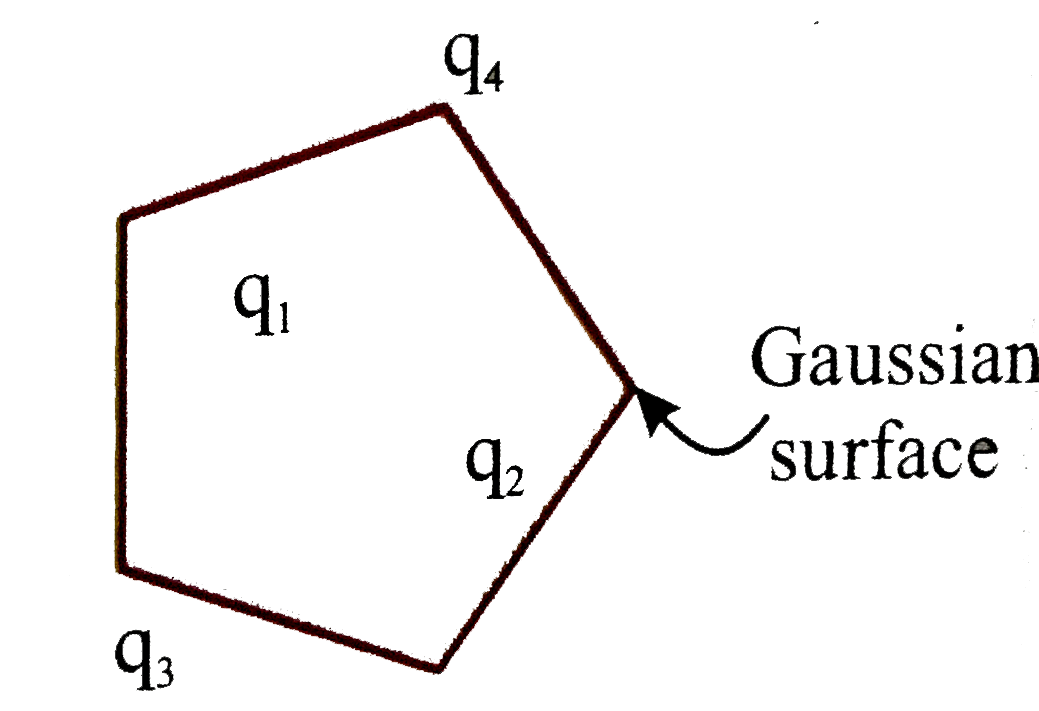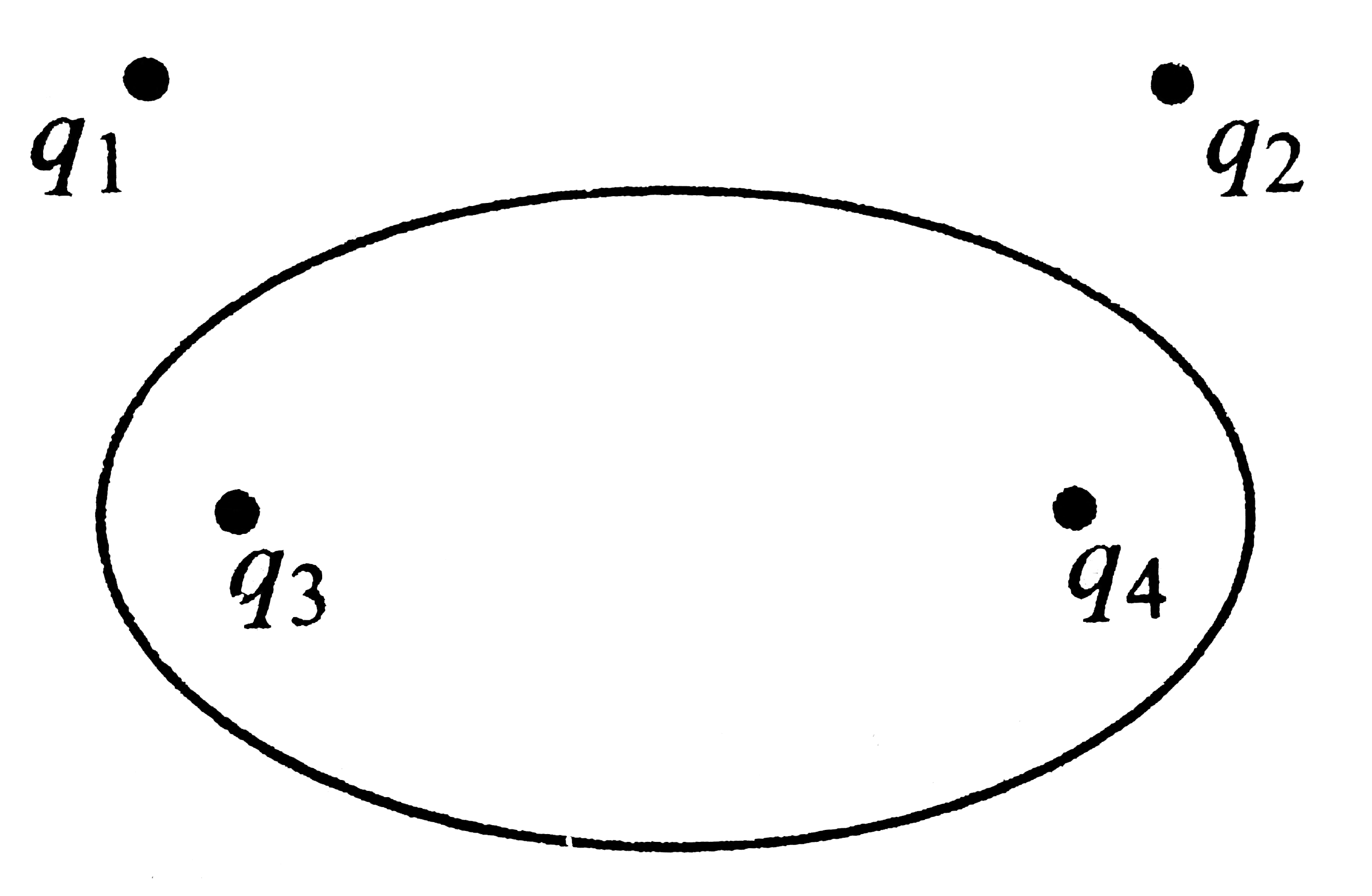Five charges q!,q2,q3,q4 and q5 are fixed at their positions as shown in figure. S is a Gaussian surface.
The Gauss' theorem is given by ∮E.dS=qε0
Which of the following statements is correct ?

E on the LHS of the above equation will have a contribution from q1,q5andq3 while q on the RHS will have a contribution from q2andq4 only
E on the LHS of the above equaiton will have a contribution from q2andq3 only
E on the LHS of the above equation will have a contribution from all charges, while q on the RHS will have a contribution from q2andq4 only
Both E on the LHS and q on the RHS will have contributions from q2andq4 only
The correct Answer is:C
According to Gauss' theorem in electrostatics,
∮E.ds=qε0. Here, E is due to all the charges q1,q2,q3,q4andq5. As q is charge enclosed by the Gaussian surface, therefore q=q2+q4.
Topper's Solved these Questions
- ELECTROSTATICSBOOK - MHTCET PREVIOUS YEAR PAPERS AND PRACTICE PAPERSCHAPTER - ELECTROSTATICSEXERCISE - PRACTICE EXERCISE (Exercise 2 (MISCELLANEOUS PROBLEMS))
47 Videos
- ELECTROSTATICSBOOK - MHTCET PREVIOUS YEAR PAPERS AND PRACTICE PAPERSCHAPTER - ELECTROSTATICSEXERCISE - MHT CET Corner
29 Videos
- ELECTROSTATICSBOOK - MHTCET PREVIOUS YEAR PAPERS AND PRACTICE PAPERSCHAPTER - ELECTROSTATICSEXERCISE - MHT CET Corner
29 Videos
- ELECTRONS AND PROTONSBOOK - MHTCET PREVIOUS YEAR PAPERS AND PRACTICE PAPERSCHAPTER - ELECTRONS AND PROTONSEXERCISE - MHT CET CORNER
19 Videos
- FORCEBOOK - MHTCET PREVIOUS YEAR PAPERS AND PRACTICE PAPERSCHAPTER - FORCEEXERCISE - Exercise 2 (Miscellaneous Problems)
19 Videos
Similar Questions
five charge q1,q2,q3,q4and q5 are fixed at their positions as shown in figure .s is Gaussian surface .The Gauss's law is given by ∮→E.→ds=qε0

Which of the following statement is correct?
View SolutionFive charges q1,q2,q3,q4andq5 are fixed at their positions as shown in figure. S is Gaussian surface. The Gauss's law is given by ∮→ES⋅→ds=qε0. Which of the following statements is correct?

View Solution
Knowledge Check
five charge q1,q2,q3,q4and q5 are fixed at their positions as shown in figure .s is Gaussian surface .The Gauss's law is given by ∮→E.→ds=qε0

Which of the following statement is correct?A→E on the L.H.S of the above equation will have a contribution from q1,q5,and.q3 while q on the RHS will have a contribution from q2 and q4 only.B→E on the LHS of the above equation will have a contribution from all charges while q on the RHS will have a contribution from q2 and q4 only.C→E on the LHS of the above equation will have a contribution form all charges while q on the RHS will have a contribution from q1 q2 and q5 only.DBoth →E on the LHS and q on the RHS will have a contribution form q(2) and q4 only.q1,q2,q3 and q4 are point charges located at point as shown in the figure and S is a spherical Gaussian surface of radius R. Which of the following is true according to the Gauss's law
 A∮s(→E1+→E2+→E3).d→A=q1+q2+q32ε0B∮s(→E1+→E2+→E3).d→A=(q1+q2+q3)ε0C∮s(→E1+→E2+→E3).d→A=(q1+q2+q3+q4)2ε0DNone of these
A∮s(→E1+→E2+→E3).d→A=q1+q2+q32ε0B∮s(→E1+→E2+→E3).d→A=(q1+q2+q3)ε0C∮s(→E1+→E2+→E3).d→A=(q1+q2+q3+q4)2ε0DNone of theseTwo fixed charges −2Q and +Q are located at points (−3a,0) and (+3a,0) respectively. Then which of the following statement is correct?
APoints where the electric potential due to the two charges is zero in x-y plane, lie on a circle radius 4a and centre (5a,0)Bpotential is zero at x=a and x=9aCboth a and b are wrongDboth a and b are correct
q1,q2,q3 and q4 are point charges located at point as shown in the figure and s is a spherical Gaussian surface of radius R. Which of the following is true according to the Gauss's law

View SolutionTwo fixed charges −2Q and +Q are located at points (−3a,0) and (+3a,0) respectively. Then which of the following statement is correct?
View SolutionAssertion: Four point charges q1,q2,q3 and q4 are as shown in Fig,The flux over the shown Gaussians surface depends only on charges q1 and q2
Reason:Electric field at all points on Gaussians surface depends on any charges q1 and q2

View SolutionThe value of charge q1,q2andq3 as shown in the figure are

View SolutionFigure shows four charges q1,q2,q3,andq4 fixed is space. Then the total flux of the electric field through a closed surface S, due to all the charges, is

View Solution
